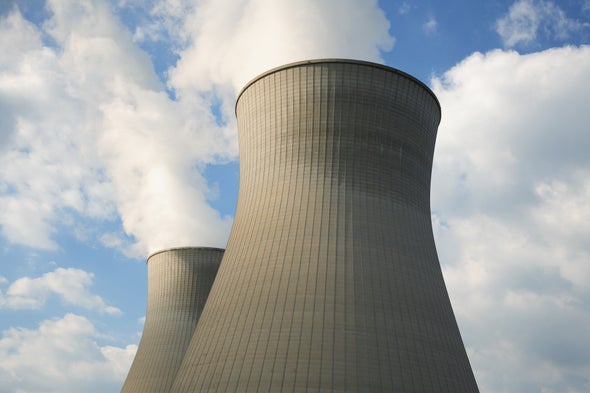U.S. Plan to Put Weapons-Grade Uranium in a Civilian Reactor Is Dangerous and Unnecessary - Scientific American
U.S. Plan to Put Weapons-Grade Uranium in a Civilian Reactor Is Dangerous and Unnecessary
https://www.
The Biden administration’s intention to use dozens of bombs’ worth of highly enriched uranium as fuel in a new civilian reactor sets a dangerous precedent, one that could help our foes get nuclear weapons
- By Alan J. Kuperman on

Perhaps the easiest path to making a nuclear weapon, for a country or terrorist seeking one, is to extract a sufficient amount of weapons-grade, highly enriched uranium (HEU) from the nominally peaceful fuel in a research reactor, the small type operating in dozens of countries, including many that lack larger nuclear power plants. According to the late Manhattan Project physicist Luis Alvarez, even high school students “would have a good chance of setting off a high-yield explosion simply by dropping one half of the material onto the other half.” That is why the U.S. nearly half a century ago initiated a program to gradually eliminate such dangerous fuel from these facilities. Now, however, in a stunning reversal, the U.S. Energy Department is actually increasing the likelihood of that deadly scenario by supplying a new research reactor with enough weapons-grade uranium for a sizable nuclear arsenal.
The danger is not just hypothetical. In 1990, Iraqi president Saddam Hussein secretly ordered a crash program to extract HEU from his foreign-supplied research reactor fuel to make an atomic bomb—after his invasion of neighboring Kuwait—but a U.N. intervention fortunately evicted his troops and interrupted the plot before it could succeed.
To prevent such grave risks, the U.S. government since the 1970s has spearheaded an international collaboration to eliminate HEU from research reactors by substituting low enriched uranium (LEU) fuel, the type used in nuclear power plants that is unsuitable for nuclear weapons. (LEU is enriched below 20 percent in the chain-reacting isotope uranium-235, making it unsuitable for nuclear weapons, whereas HEU fuel in research reactors typically is enriched to 93 percent, the same as in U.S. nuclear weapons.) The U.S.-led program has helped contain nuclear proliferation and prevent nuclear terrorism by converting 71 reactors in the U.S. and abroad from HEU to LEU fuel, even tiny ones containing only one kilogram of HEU. The U.S. has not built an HEU-fueled civilian reactor since the 1970s, and no other country has done so since the 1990s.
However the Biden administration intends to violate this nonproliferation policy by supplying over 600 kilograms of weapons-grade uranium—enough for dozens of nuclear weapons—to a privately owned experimental research reactor that would be largely funded by the U.S. government. If the project proceeds, other countries will insist on violating the policy too, refusing to accept a double standard. Whether they import HEU from the United States, purchase it from Russia or build their own enrichment plants, the risks of nuclear proliferation and terrorism will grow again.
The U.S. government is providing $90 million of the $113 million cost to build the Molten Chloride Reactor Experiment (MCRE), which aims to research the potential for a commercial version known as the Molten Chloride Fast Reactor. Although no such power plants exist, they would in theory employ a loop of liquid fuel—uranium dissolved in hot salt—to both sustain the fission reaction and transport the resulting heat. Advocates claim that using liquid fuel, instead of the solid fuel now used in all nuclear power plants, would be a more efficient way to produce electricity and heat for industrial uses. This is not an entirely new concept. In the 1960s, a similar Molten Salt Reactor Experiment was tried but largely failed at Oak Ridge National Laboratory—partly in consequence of the corrosive combination of salt, high temperature and radiation—and it left a particularly nasty radioactive waste problem that still persists. Six decades later, the Energy Department has decided to throw good money after bad.
The technical tweak of the MCRE is to utilize “fast” (high-energy) neutrons rather than the “thermal” (lower-energy) neutrons used in all U.S. nuclear power plants and the 1960s experiment. Fast neutrons facilitate the fission of some radioactive, human-made elements produced in reactors and so can reduce slightly the long-lived radioactivity of the nuclear waste created. But fast neutrons are much less able to induce fission in uranium-235, which is essential for the chain reaction to power the reactor. So, the fuel needs a larger percentage of this isotope, entailing higher uranium-235 enrichment than the 4 percent enriched LEU typically used in nuclear power plants.
However, molten salt fast reactors such as the proposed MCRE do not require HEU. This fact is undisputed because both the Biden administration and its private partners acknowledge that a commercial version, if ever built, would use LEU fuel.
So, if the reactor could use LEU fuel, why is the Biden administration funding an HEU version that would violate U.S. nonproliferation policy?
The last time that shortsighted U.S. officials planned to build an HEU-fueled research reactor, in the early 1990s, “opposition to the use of highly-enriched uranium in the reactor's core led to its cancellation” by President Bill Clinton. The only question is whether Joe Biden will again demonstrate such U.S. leadership, or gratuitously undermine one of the world’s most successful nuclear nonproliferation programs.
This is an opinion and analysis article, and the views expressed by the author or authors are not necessarily those of Scientific American.
Alan J. Kuperman is associate professor and coordinator of the Nuclear Proliferation Prevention Project at the LBJ School of Public Affairs, University of Texas at Austin, and author of a history of HEU minimization policy.
- Log in to post comments


